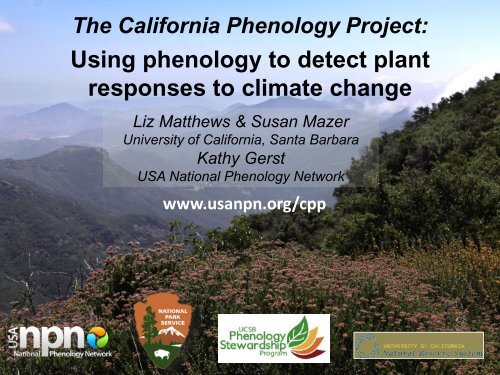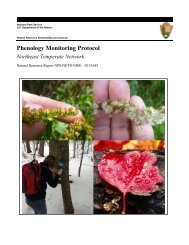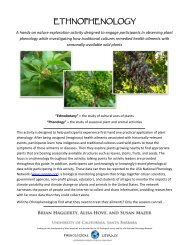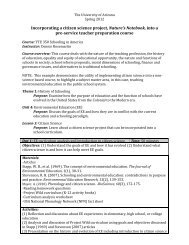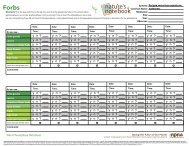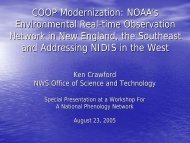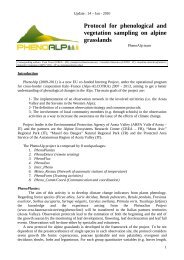CPP - USA National Phenology Network
CPP - USA National Phenology Network
CPP - USA National Phenology Network
Create successful ePaper yourself
Turn your PDF publications into a flip-book with our unique Google optimized e-Paper software.
<strong>Phenology</strong> is the science of the seasonsSpring wildflowersMigration patternsFoliage color changeOther examples?5
<strong>Phenology</strong>: economic importanceWildfiresFlu seasonFestivalsEcotourismPests & DiseasesAllergiesInvasionsAgriculture
Phenological indicators used by fisherman:plant phenophases can predict the best time to huntFisherman on the east coast of Canada would not fish forshad (Alosa sapisissima) until after the shadbush(Amelanchier spp.) flowered.Beaubien, E.G. 1991. <strong>Phenology</strong> of Vascular Plant Flowering in Edmonton and across Alberta. MS thesis,University of Alberta.
Phenological indicators used by hunters:plant phenophases can predict the best time to huntTurner et al., 1980. Ethnobotany of the Okanagan-Colville Indians of British Columbia and Washington. Occ. Pap.Brit. Col. Prov. Mus. No. 21., Ministry of Provincial Secretary and Government Services Provincial Secretary,Victoria, B.C.Okanagan indians used blooming of mock-orange(Philadelphus lewisii) as an indicator that marmotswere fat and ready to hunt.
Phenological indicators used by indigenous people:plant phenophases can predict harvest times ofanimalsThe Nuu-Chah-Nulth tribe of Vancouver Island used the ripening ofsalmonberries (Rubus spectabilis) to predict the return of adultsockeye salmon (Oncorhynchus keta) to freshwater.Bouchard & Kennedy, 1990. Clayoquot Sound Indian Land Use. Report prepared for MacMillan Bloedel Ltd.Peacock, S. L. 1992 Piikani Ethnobotany: Traditional Plant Knowledge of the Piikani Peoples of the NorthwestPlains. MS thesis, University of Calgary.
Phenological indicators used by indigenous people:plant phenophases can predict harvest times ofanimalsThe Blackfoot tribe of s. Alberta and Canada used the flowering of thebuffalo bean (Thermopsis rhombifolia) to indicate that bison males(Bison bison) had eaten enough spring browse to be ready to hunt(their meat was sufficiently marbled with fat).Johnston A. 1982. Plants and the Blackfoot. Prov. Mus. Alberta Nat. Hist. Occ. Pap. No. 4, Alberta Culture,Historical Resources Division, Edmonton, Alberta.
Phenological Indicators used by indigenous people:plant phenophases at one location can predict harvesttimes for plants at another locationThe Tubatulabal tribe of Kern County (CA) used the ripening ofcoffeeberry fruits (Rhamnus californica) at low elevations to indicatethat pinyon pine (Pinus monophylla) seeds in the mountains wereready to harvest.Anderson, M. Kat. 2002. UC Davis.
<strong>Phenology</strong>: biological importancePlants & animals are dynamic over the seasonsVegetative phenologyReproductive phenology
<strong>Phenology</strong>: biological importancePlants & animals are dynamic over the seasonsVegetative phenology:• Leaves provide energy to the plant for reproduction & growth,food for herbivores, shade and protection for understoryanimals• Influences global biogeochemical cycles (e.g., C-cycle)
<strong>Phenology</strong>: biological importancePlants & animals are dynamic over the seasonsReproductive phenology:• Plant reproduction depends on flowers fruits• Many flowers provide nectar & pollen for pollinators• Many plants provide fruits & seeds for animals
Phenological patterns areimportant, economically andbiologically… and sensitive to climate… and sensitive to climate change.“<strong>Phenology</strong>…is perhaps the simplestprocess in which to track changes in theecology of species in response to climatechange.” (IPCC 2007)“Because of their close connection withclimate, the timing of phenological eventscan be accurate indicators of climatechange.” (EPA 2010)
OUTLINE• What is phenology? How is phenology related toclimate and climate change?– Case studies• California <strong>Phenology</strong> Project (<strong>CPP</strong>)• <strong>USA</strong> <strong>National</strong> <strong>Phenology</strong> <strong>Network</strong> (<strong>USA</strong>-NPN)• Botany for <strong>CPP</strong> observers16
Common Lilac Monitoring Nationwide• The first phenological monitoring effort in the U.S.• 1950’s - 1990’s: ~3500 private citizens monitored lilacplants in backyards and gardens• Each year, they sent postcards reporting the date offirst bloom to Professor Joe Caprio at Montana StateUniv.• First bloom dates of these lilacs have been used:• To show the effects of elevation and latitude on the onset ofspring• To generate predictive maps for safe sowing dates• To assess climate change throughout the U.S.
Common Lilac Leaf Phenophases
Common Lilac Monitoring NationwideMany individuals tracked overtime… what about one individual?
<strong>Phenology</strong> is an indicator of environmental change<strong>Phenology</strong> for one LilacindividualDate of first flowerDate of first leafPhenological events in this lilac have advanced asthe climate has warmed20
“Phenological mismatches” may cause populationcrashesLeafing out earlierEmerging earlierWinter mothEnglish oakPied flycatcherMigrating the same timeeach yearBird populations have declined by90% where food for nestlings ispeaking earlier in the season andthe birds’ arrival and breedingevents are now mistimed.Both et al. 2006 Nature21
Shifts in phenology result in changes in body mass andpopulation dynamics(a) time of weaning(b) mean mass on August 1 st(c) total abundance at eachage classOzgul et al. 201022
Can you think of other potential ecological consequences ofchanges in plant phenology as a result of climate change?Can you think of a few potential economic consequences ofchanges in plant phenology as a result of climate change?23
OUTLINE• What is phenology? How is phenology related toclimate and climate change?– Case studies• California <strong>Phenology</strong> Project (<strong>CPP</strong>)• <strong>USA</strong> <strong>National</strong> <strong>Phenology</strong> <strong>Network</strong> (<strong>USA</strong>-NPN)• Botany for <strong>CPP</strong> observers24
California <strong>Phenology</strong> Project25
California <strong>Phenology</strong> Project: Goalsestablish a coordinated phenological monitoring networkmonitor across a large geographic area and along keyenvironmental gradients1) address important scientific questions,2) guide resource management decisions, &3) educate the public about phenology & climatechange research26
California <strong>Phenology</strong> Project• identify key scientific questions• facilitate selection of focal species forthree bioregions (desert, coastal,mountains)• identify historical datasets• develop phenophase descriptionsappropriate for California plant taxa• develop and refine monitoring protocols,infrastructure, and tools in pilot parks• develop outreach and educationprograms to engage Citizen Scientists inphenological monitoring27
<strong>CPP</strong> scientific questions• What are the phenological responses of iconic,widespread species to environmental variation andclimate change?• Which taxa or functional groups are most sensitive toclimate change?• Do communities or habitats differ in their generalresponses to climate change?• Are relationships between plant and animal mutualistsdisrupted by climate change?28
<strong>CPP</strong>: focal speciesJoshua Tree, Yucca brevifolia• Ability to address scientific questions• Ability to engage Citizen Scientists• Proximity to other monitoring efforts• Species of local management concern• Indicator species29
<strong>CPP</strong> in the <strong>National</strong> Parks30
Monitoring by Citizen Scientists1. Visit and monitor labeled and mapped plants: each plant isvisited frequently when it is phenologically active(e.g., <strong>CPP</strong> plants in <strong>National</strong> Parks)2. Visit and monitor labeled (unmapped) plants whenever it’sconvenient(e.g., plants in a schoolyard)3. Visit and monitor unlabeled plants whose location you’refamiliar with(e.g., the big tree at the corner)4. Visit and monitor unlabeled plants one time, or opportunistically(e.g., plants you encounter while hiking the Pacific Crest Trail)31
<strong>CPP</strong>: monitoring infrastructureJOTRREDWGOGA32
<strong>CPP</strong>: monitoring infrastructure33
<strong>CPP</strong>: other monitoring tools39
<strong>CPP</strong>: outreach and education40
<strong>CPP</strong>: other monitoring tools41
<strong>CPP</strong>: outreach and education42
<strong>CPP</strong>: outreach and education43
<strong>CPP</strong>: outreach and education<strong>Phenology</strong> education materials available on the <strong>CPP</strong> website:• Lesson plans for primary educators• Activities for formal and informal education settings• Undergraduate lecture series• Readings and discussion questions for advanced undergraduateor graduate seminar in phenology44
California <strong>Phenology</strong> Projectwww.usanpn.org/cpp– Tools for monitoring: maps, monitoring guides,species profiles, and more– Includes a wide array of phenological educationmaterials for formal and informal settings– <strong>CPP</strong> documentation: scientific questions, speciesselectionprocess, and more– Powerpoint presentations– <strong>CPP</strong> DRAFT Interpreters’ Guide– Instructions for joining the <strong>CPP</strong> listserv45
OUTLINE• What is phenology? How is phenology related toclimate and climate change?– Case studies• California <strong>Phenology</strong> Project (<strong>CPP</strong>)• <strong>USA</strong> <strong>National</strong> <strong>Phenology</strong> <strong>Network</strong> (<strong>USA</strong>-NPN)• Botany for <strong>CPP</strong> observers46
What is the <strong>USA</strong>-NPN?A collaborative monitoring networkthat brings together citizen scientists, government agencies, nonprofitgroups, educators, and students of all ages to monitor theimpacts of climate change on plants and animals in the U.S.47
<strong>USA</strong>-NPN monitoring sites48
a project of the <strong>USA</strong>-NPNwww.usanpn.org∙ 300+ plant species∙ 160+ animal species∙ Core protocols49
Using <strong>USA</strong>-NPN datasheetsBaccharis pilularisCoyotebrush50
Using <strong>USA</strong>-NPN datasheetsBaccharis pilularisCoyotebrush51
Using <strong>USA</strong>-NPN datasheetsBaccharis pilularisCoyotebrush52
<strong>CPP</strong> species profiles53
OUTLINE• What is phenology? How is phenology related toclimate and climate change?– Case studies• California <strong>Phenology</strong> Project (<strong>CPP</strong>)• <strong>USA</strong> <strong>National</strong> <strong>Phenology</strong> <strong>Network</strong> (<strong>USA</strong>-NPN)• Botany for <strong>CPP</strong> observers54
Basic Botany ReviewVegetative structures• Leaf buds• Leaves & stemsReproductive structures• Flower buds• Flowers• Fruits & seedsPollination Fertilization Seeds & Fruits develop55
Basic Botany ReviewNodeTerminal budBud at nodeLateral budLeaf orbranchBuds may be found in several locations relative to leavesand stems. Generally, leaves ALWAYS have a bud in theiraxil, even though it may be very small
Reproductive structures: flower buds, flowers, fruits & seedsfemalemalePollination & fertilization57
Vegetative structures: breaking leaf buds, expanding leaves, and full-sized leavesCommon LilacRed ElderberryPacific Rhododendron
<strong>CPP</strong>: phenophase descriptions59
Reproductive structures: flower buds, open flowers, and fruitsJoshua TreeRed elderberry
California Buckeye phenophases61
Let’s go observe!!62


